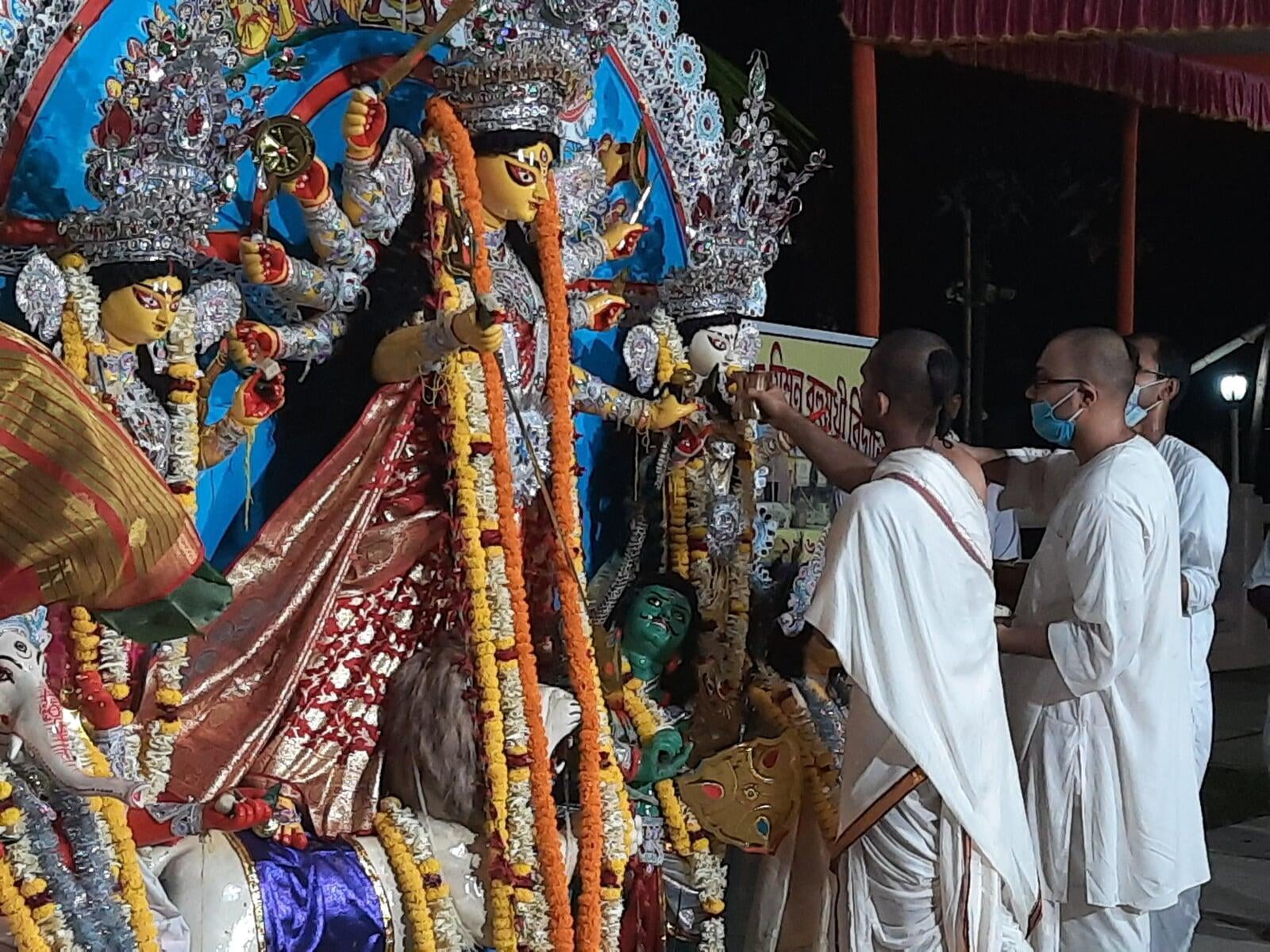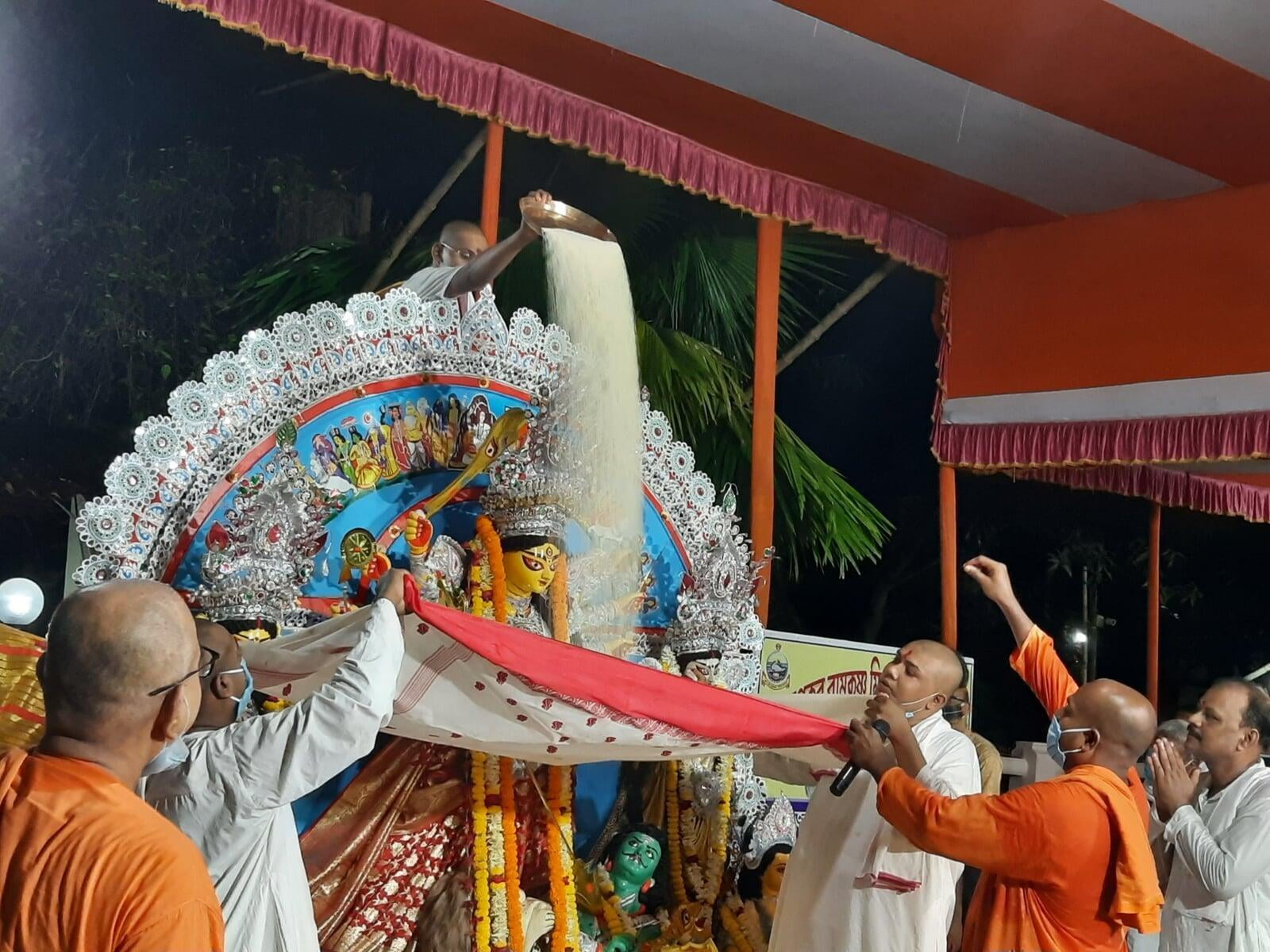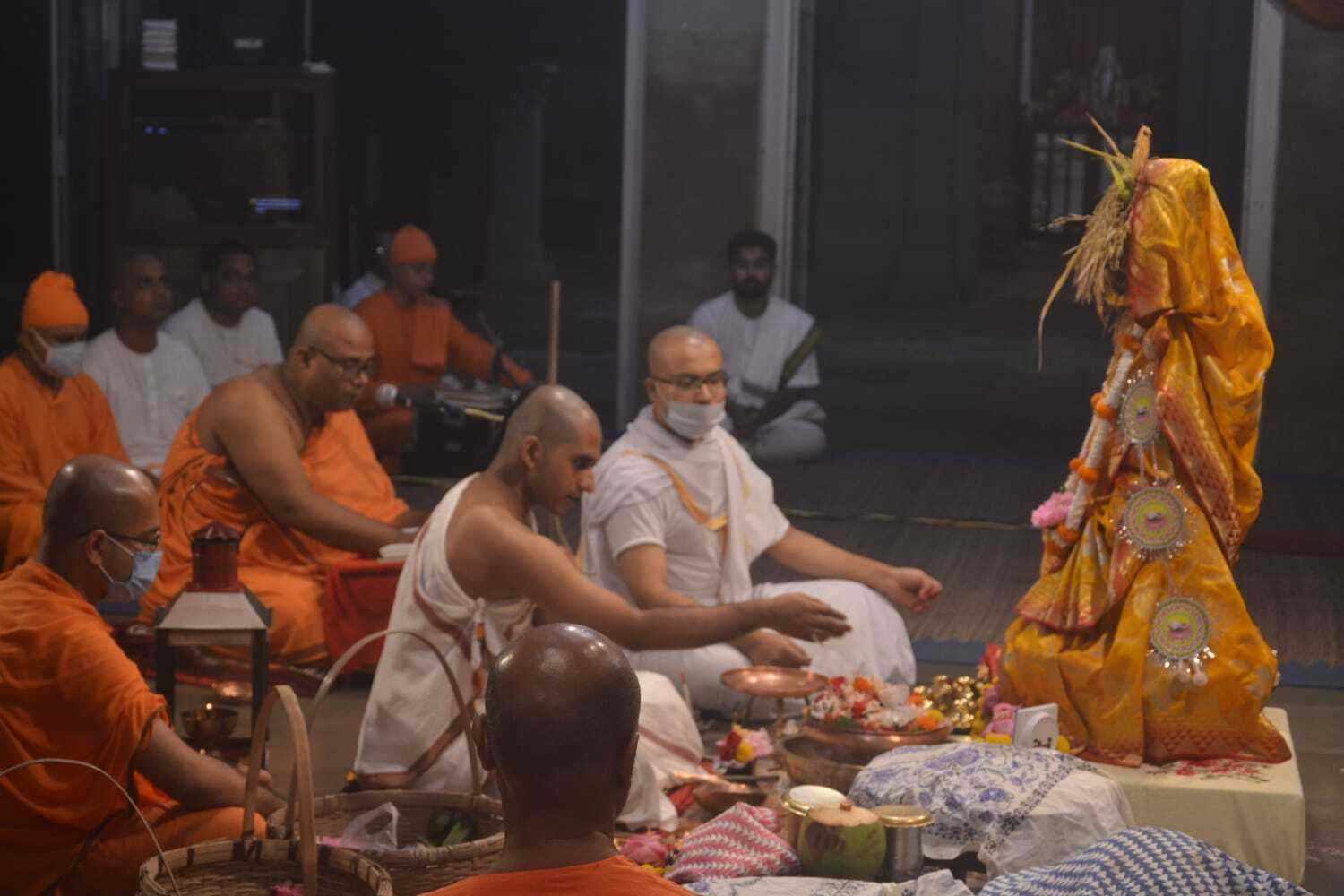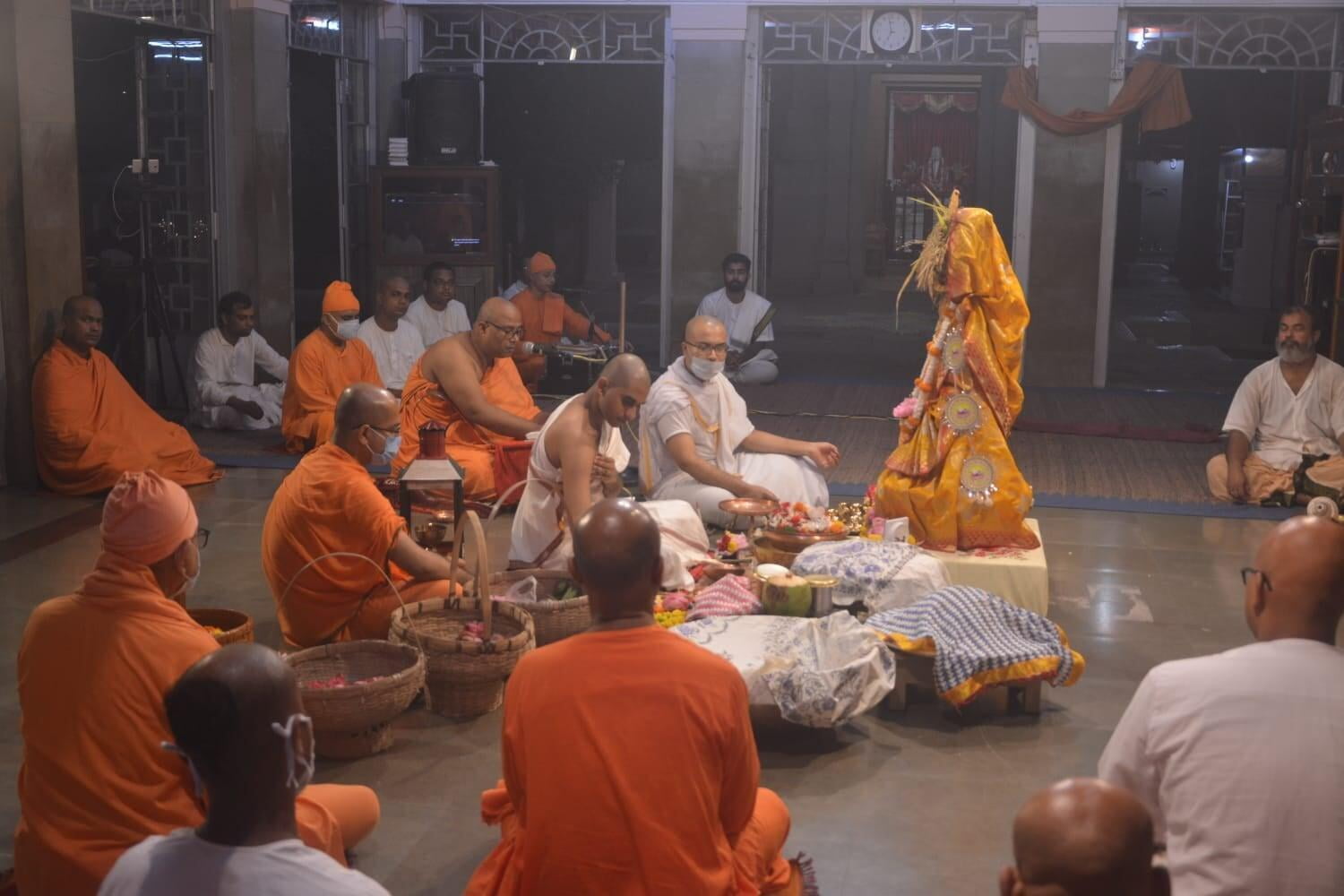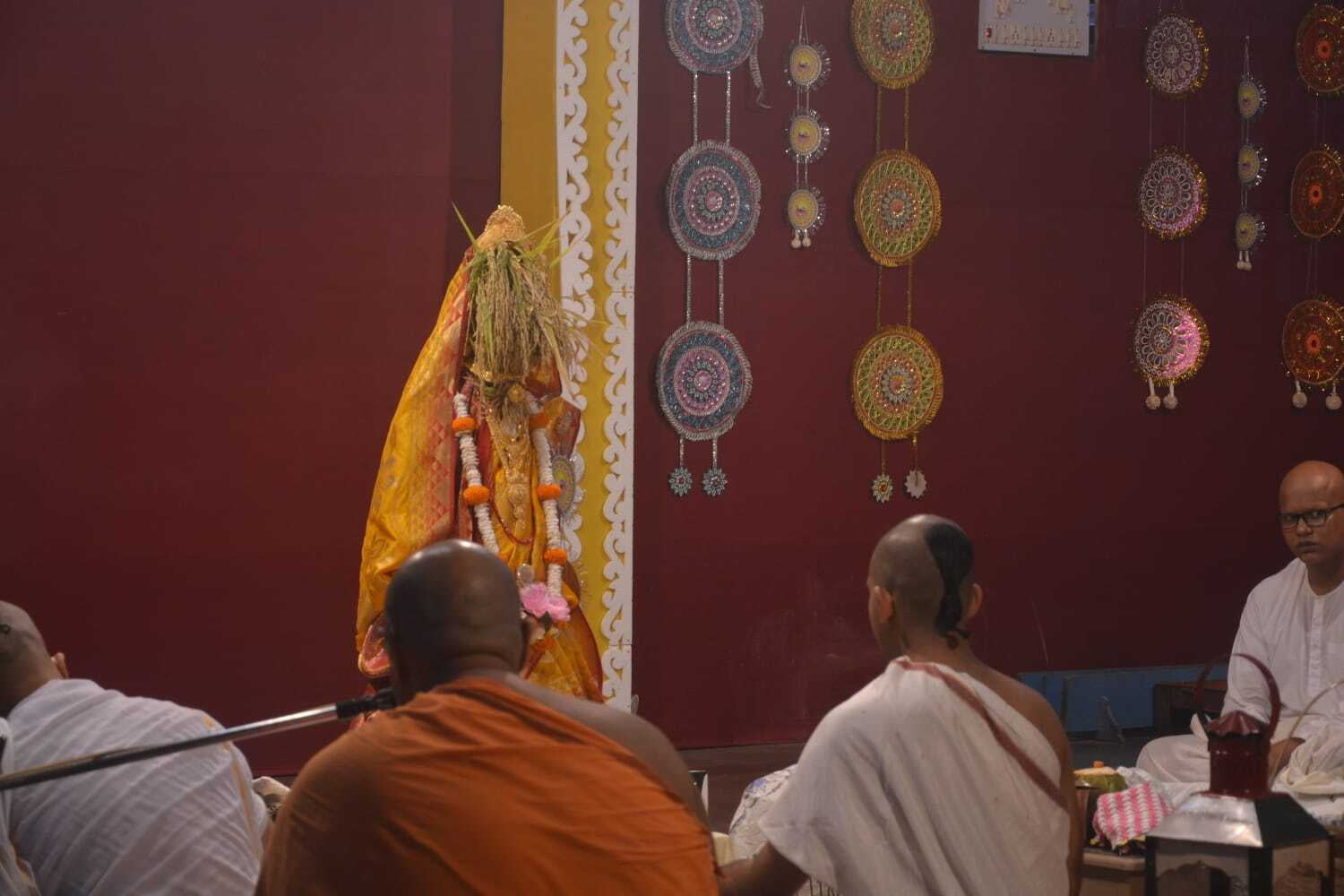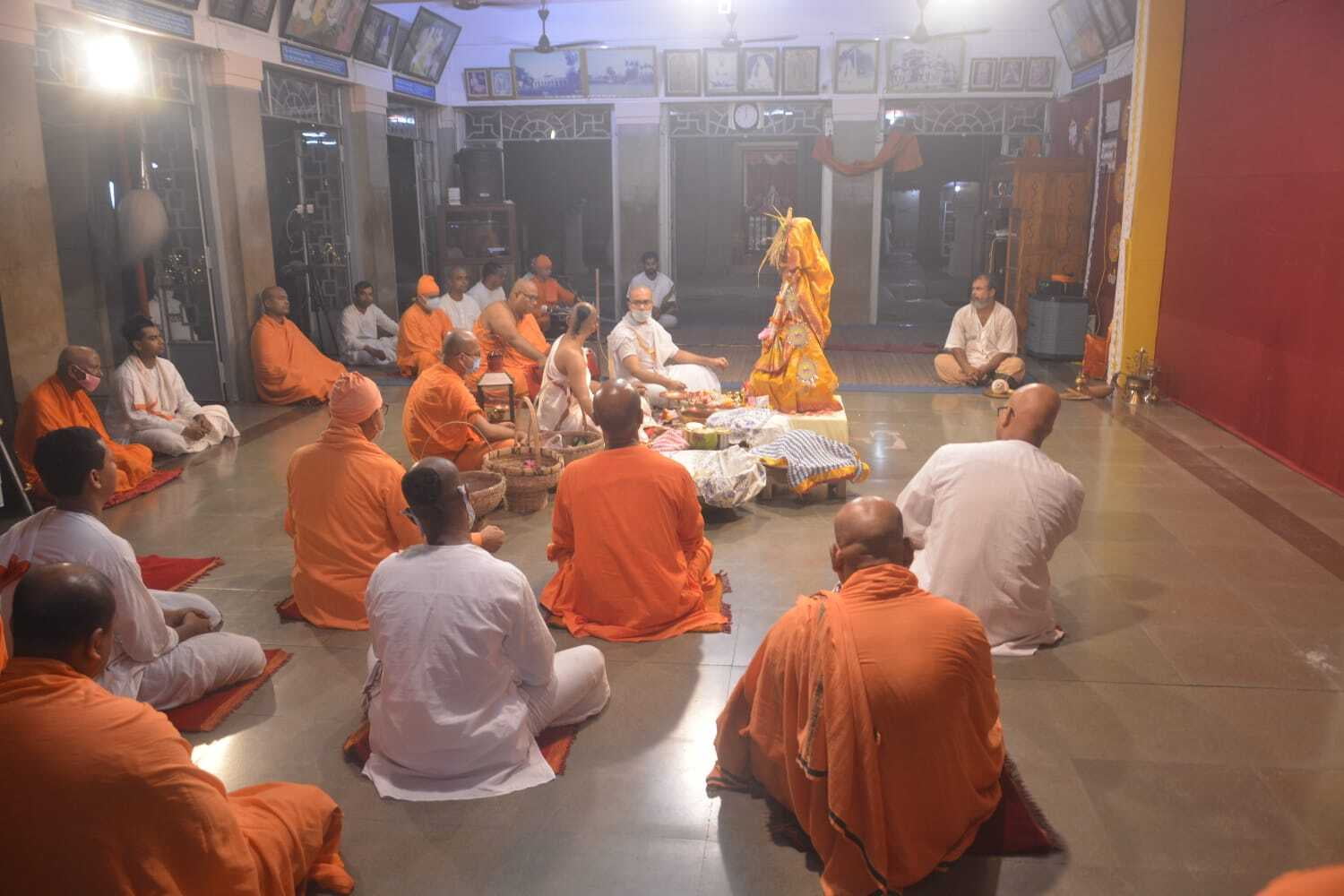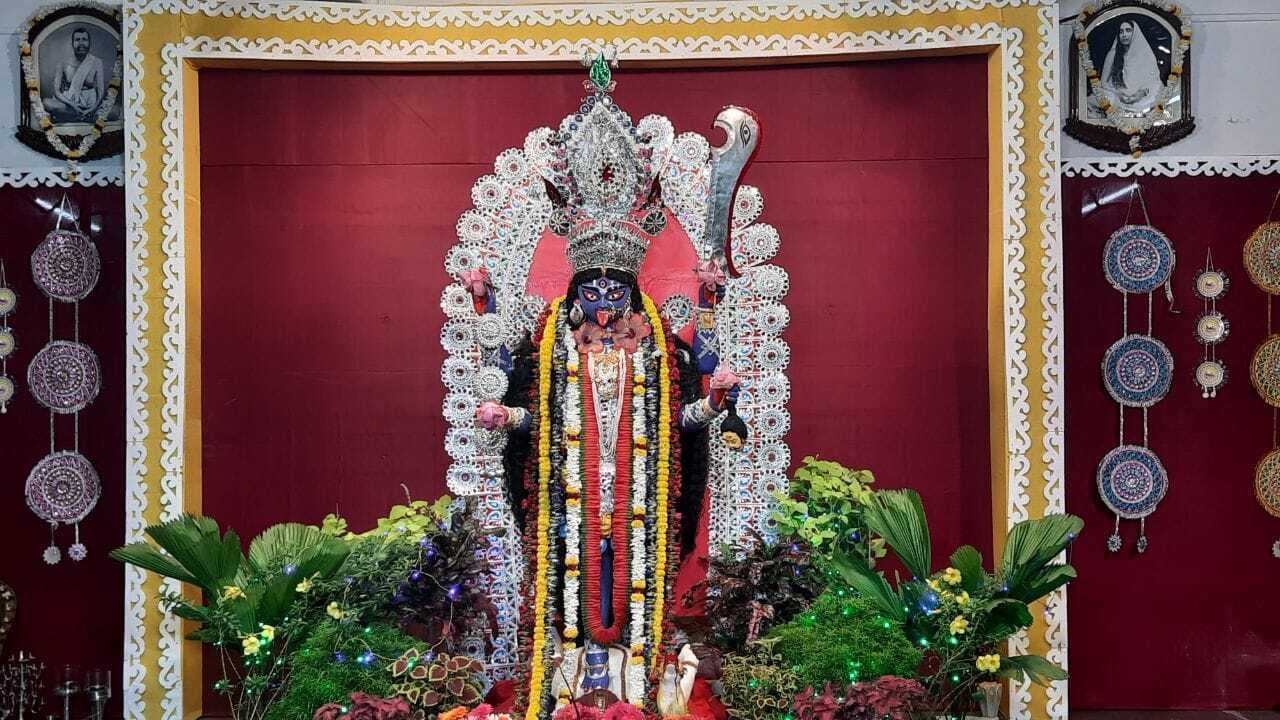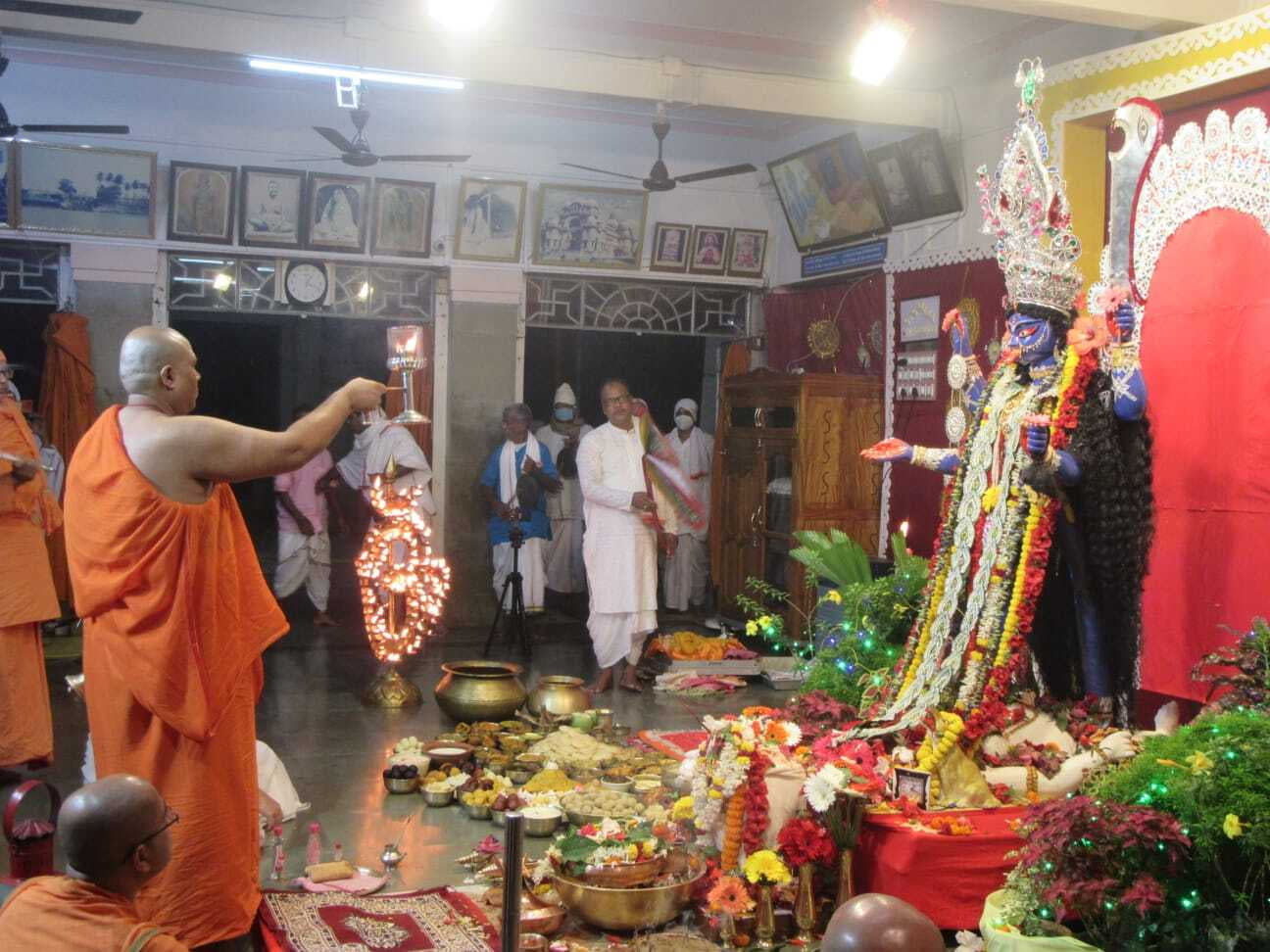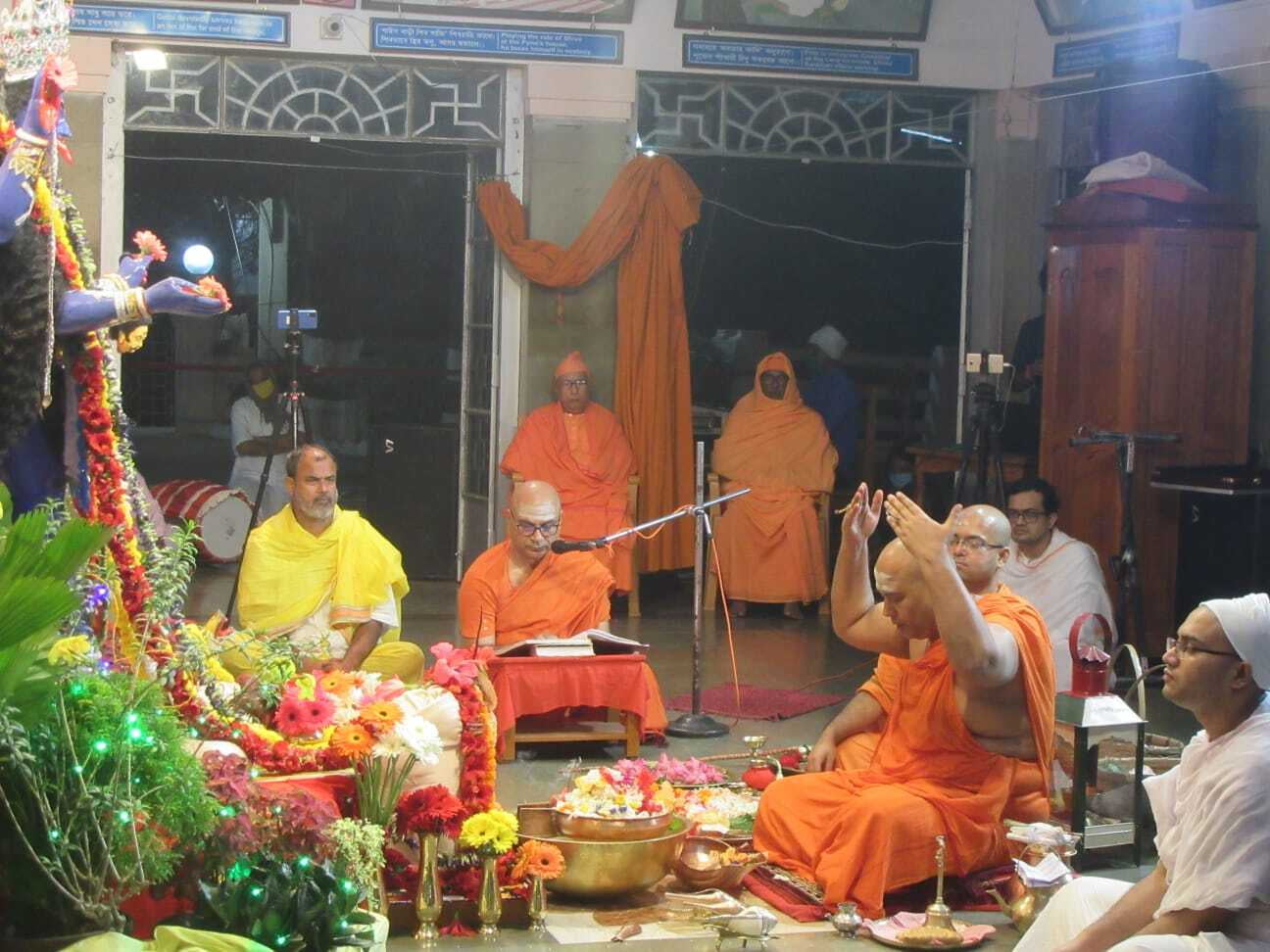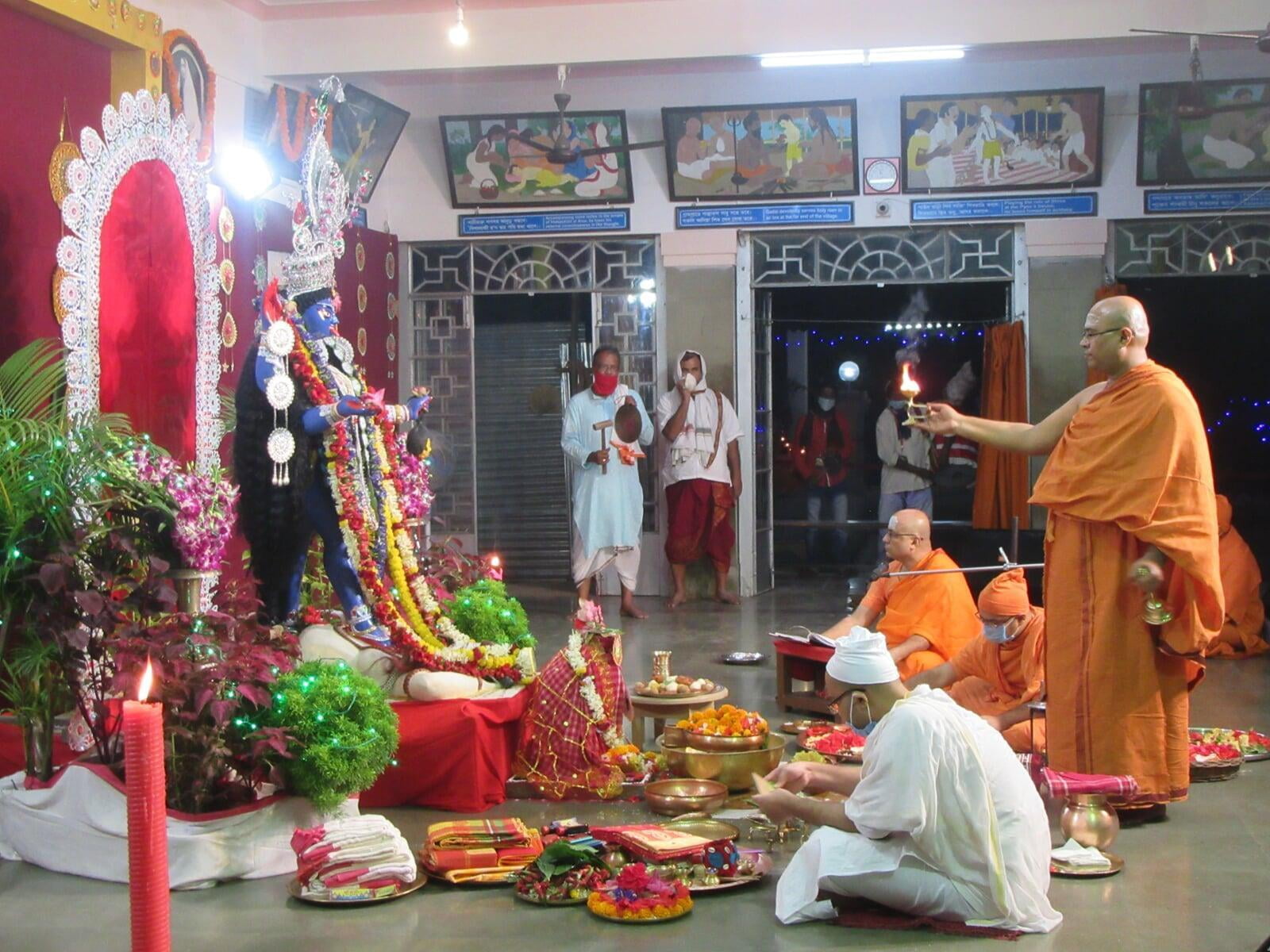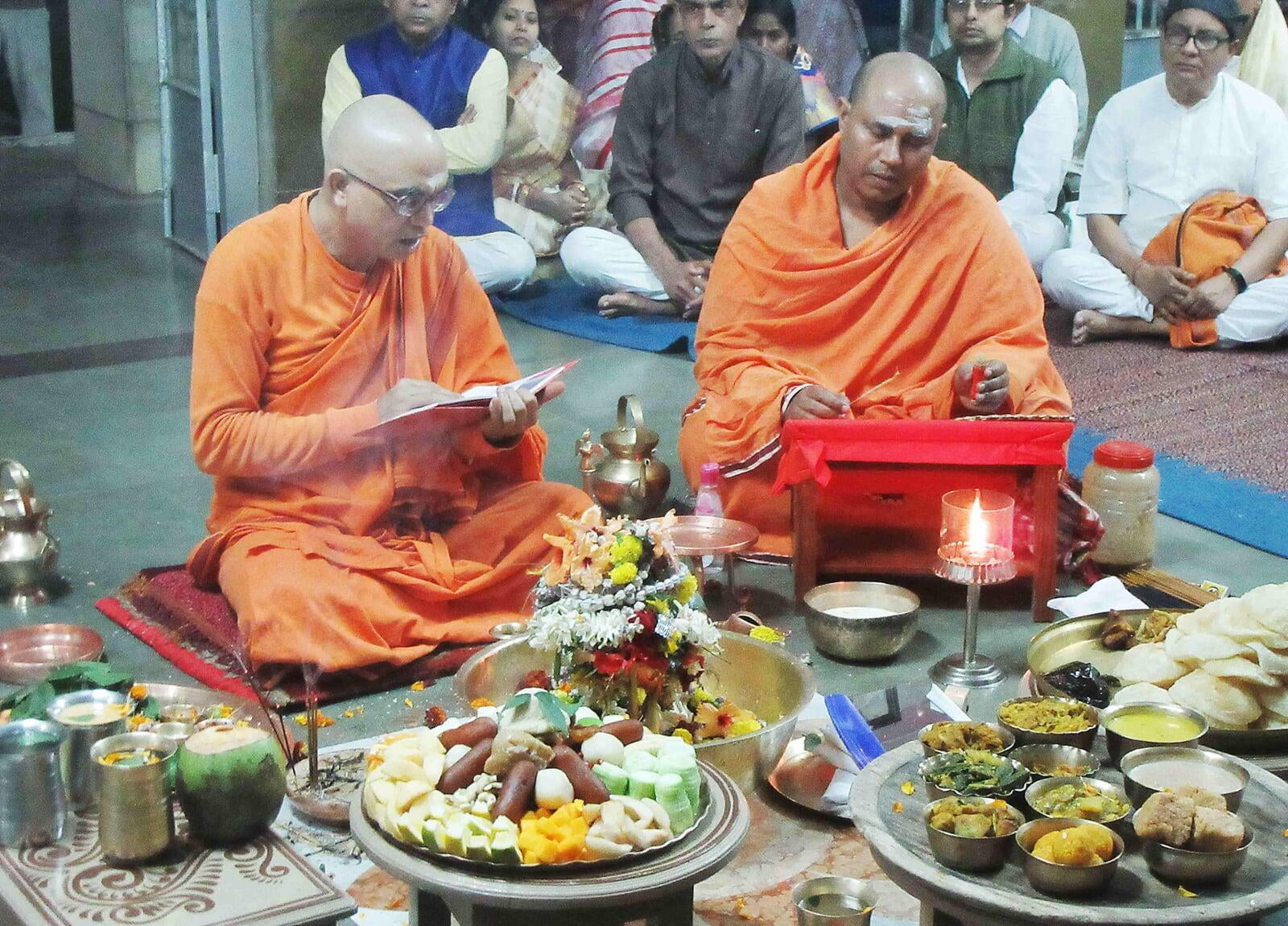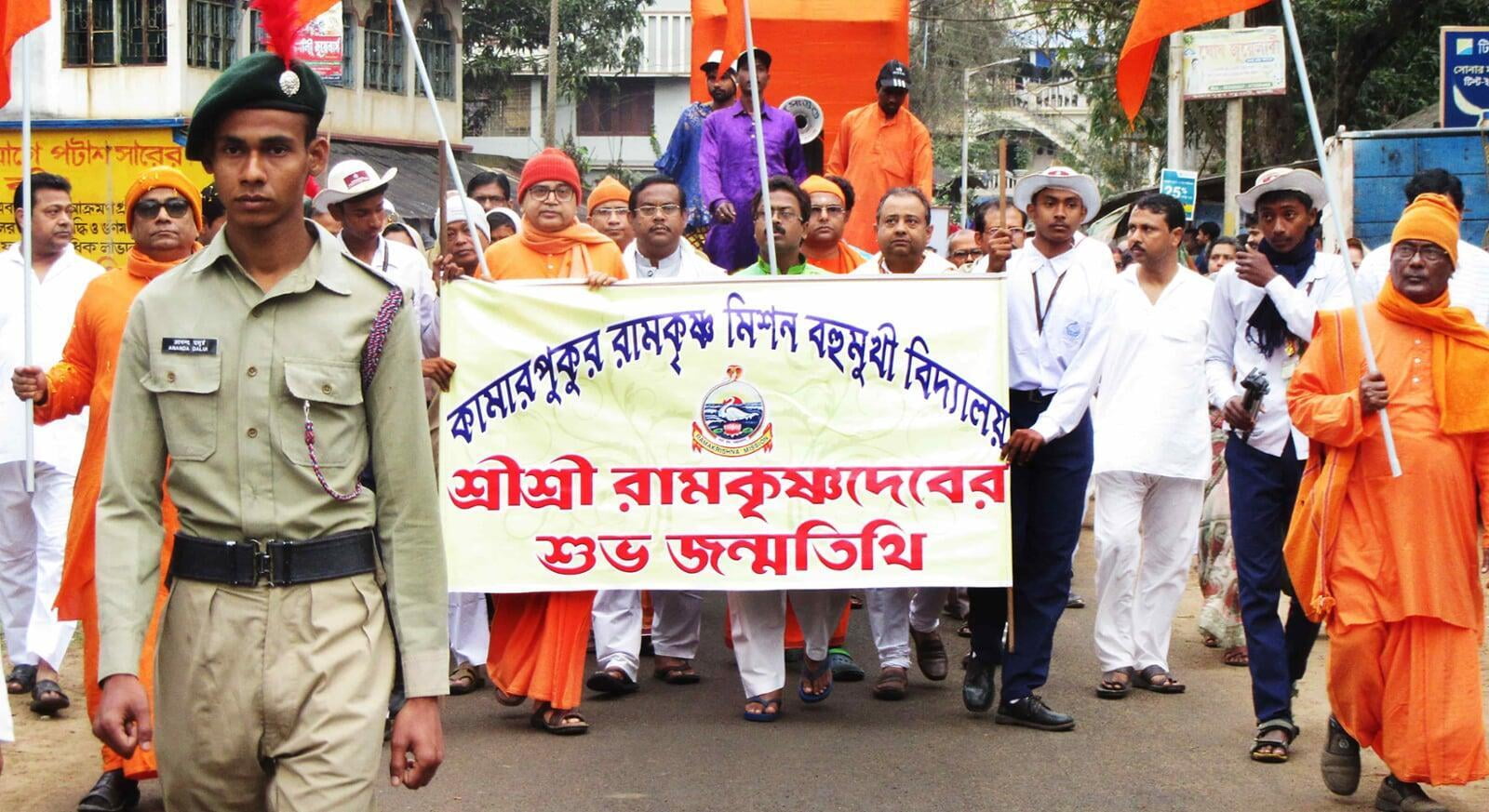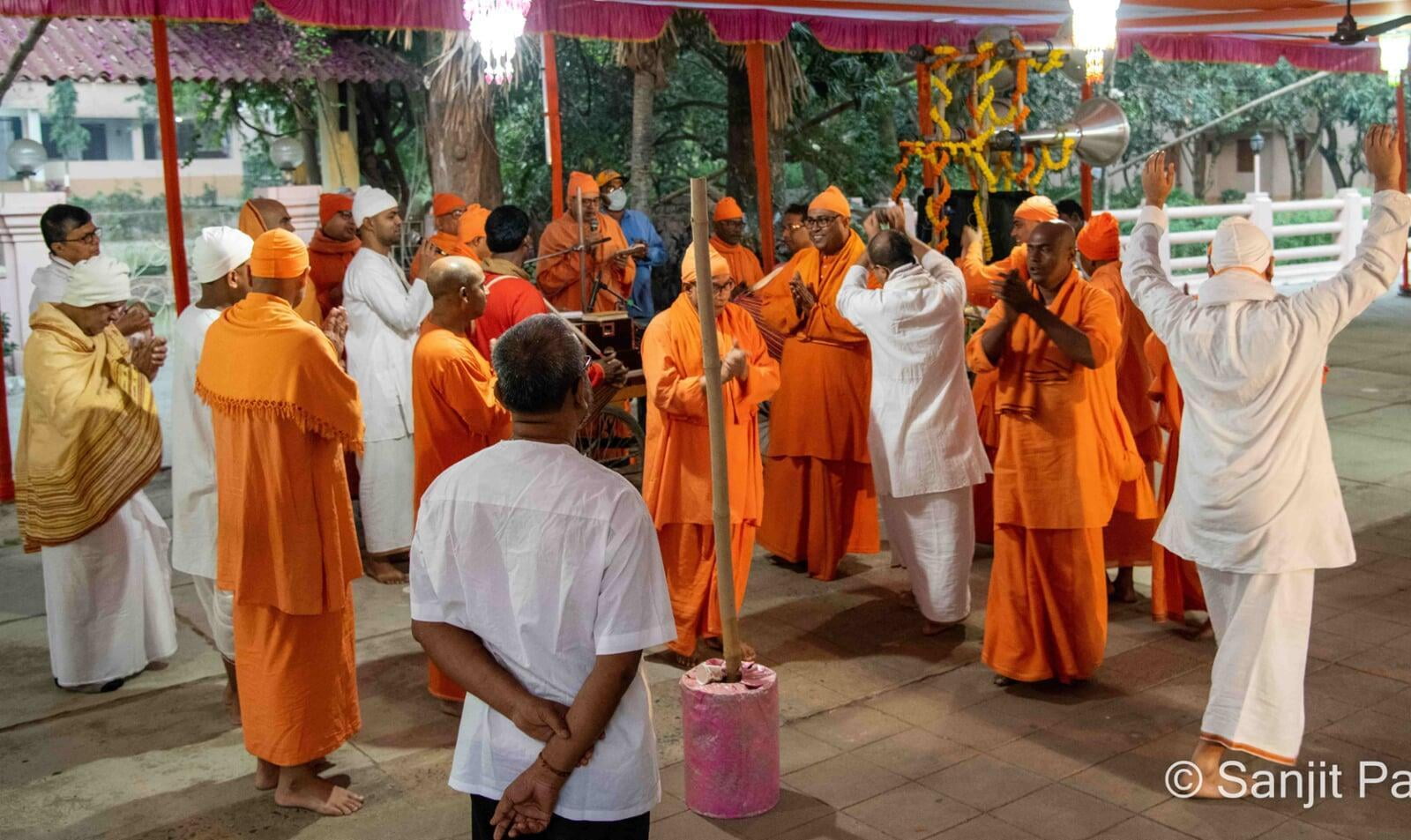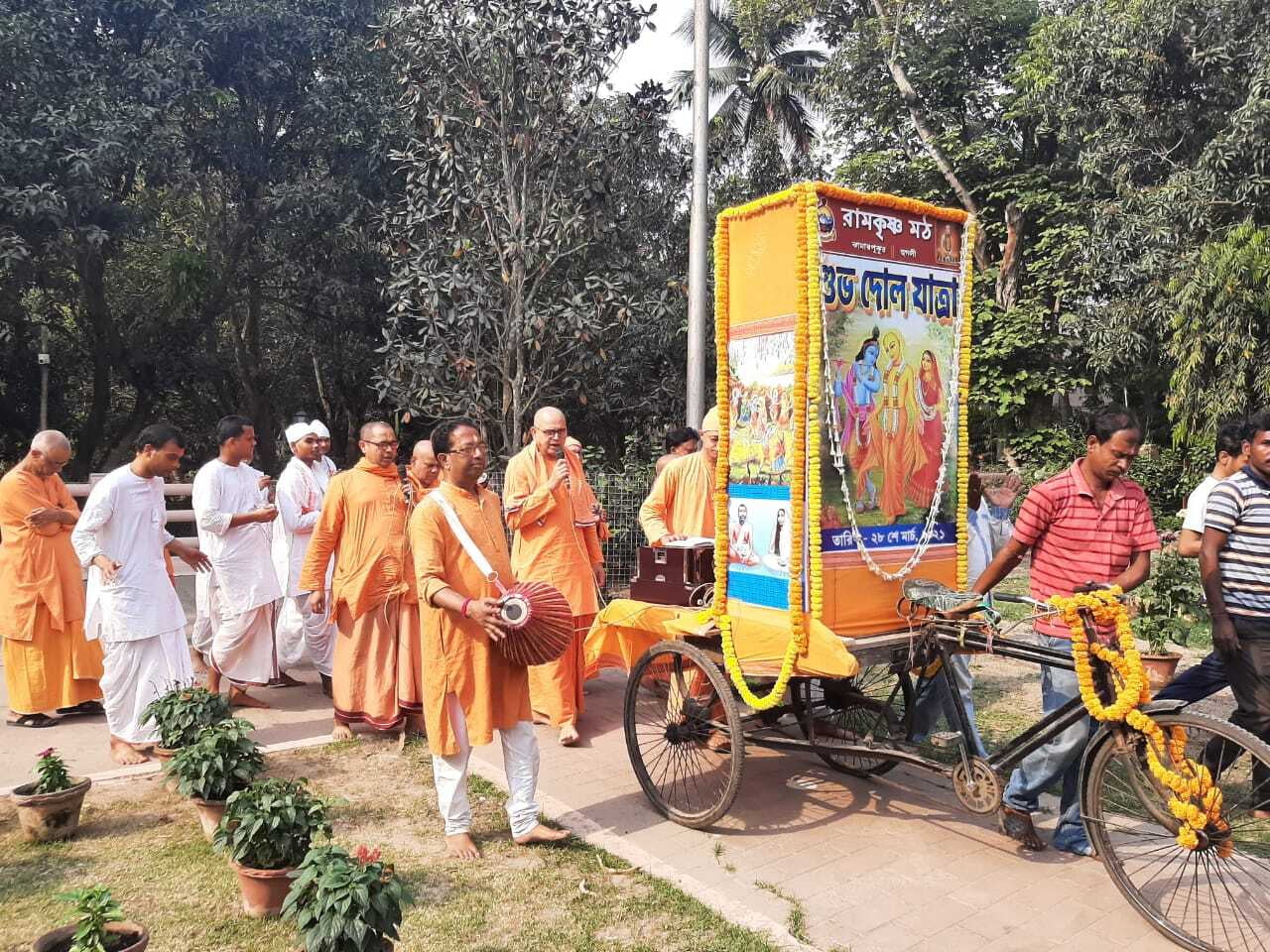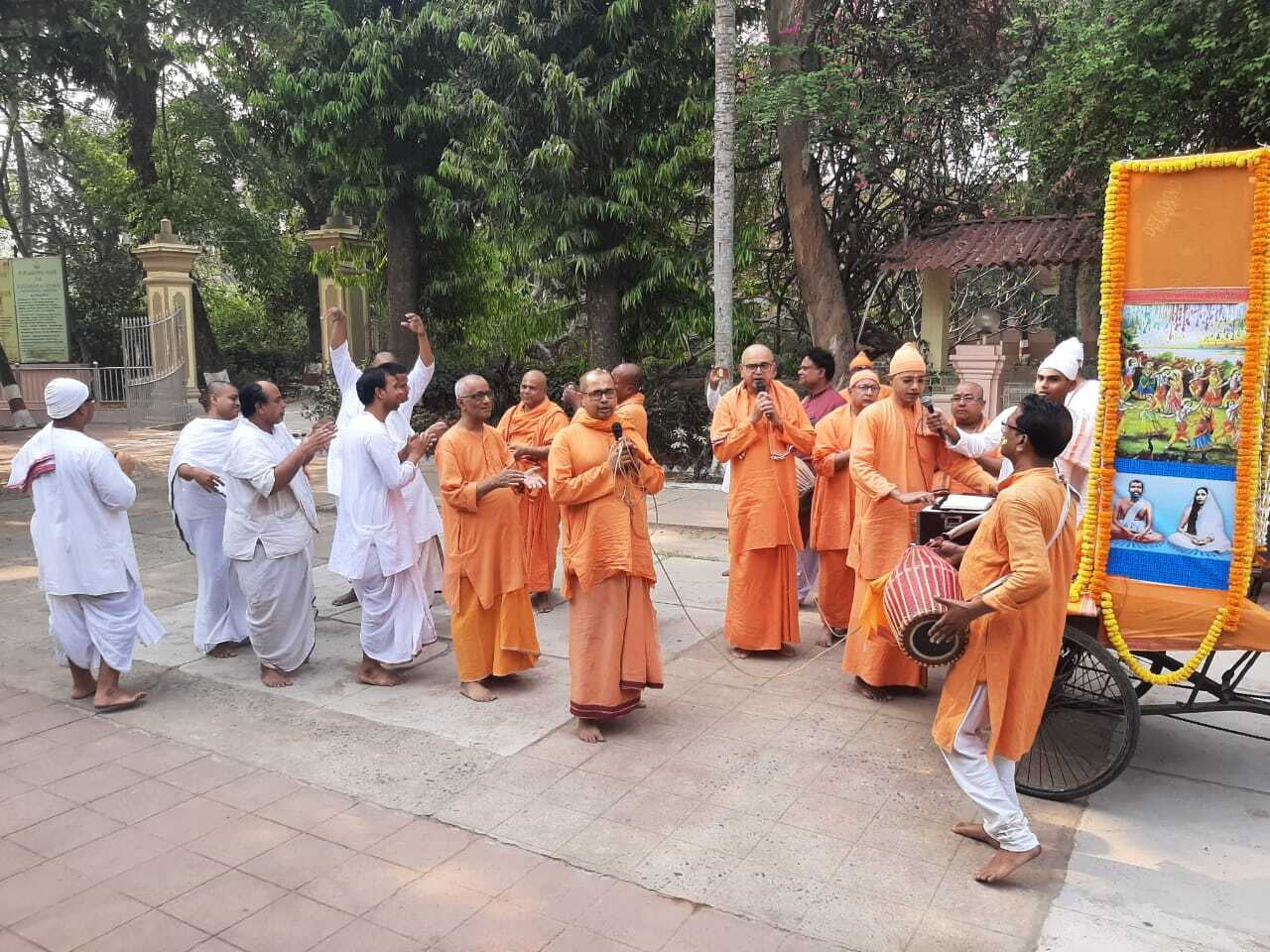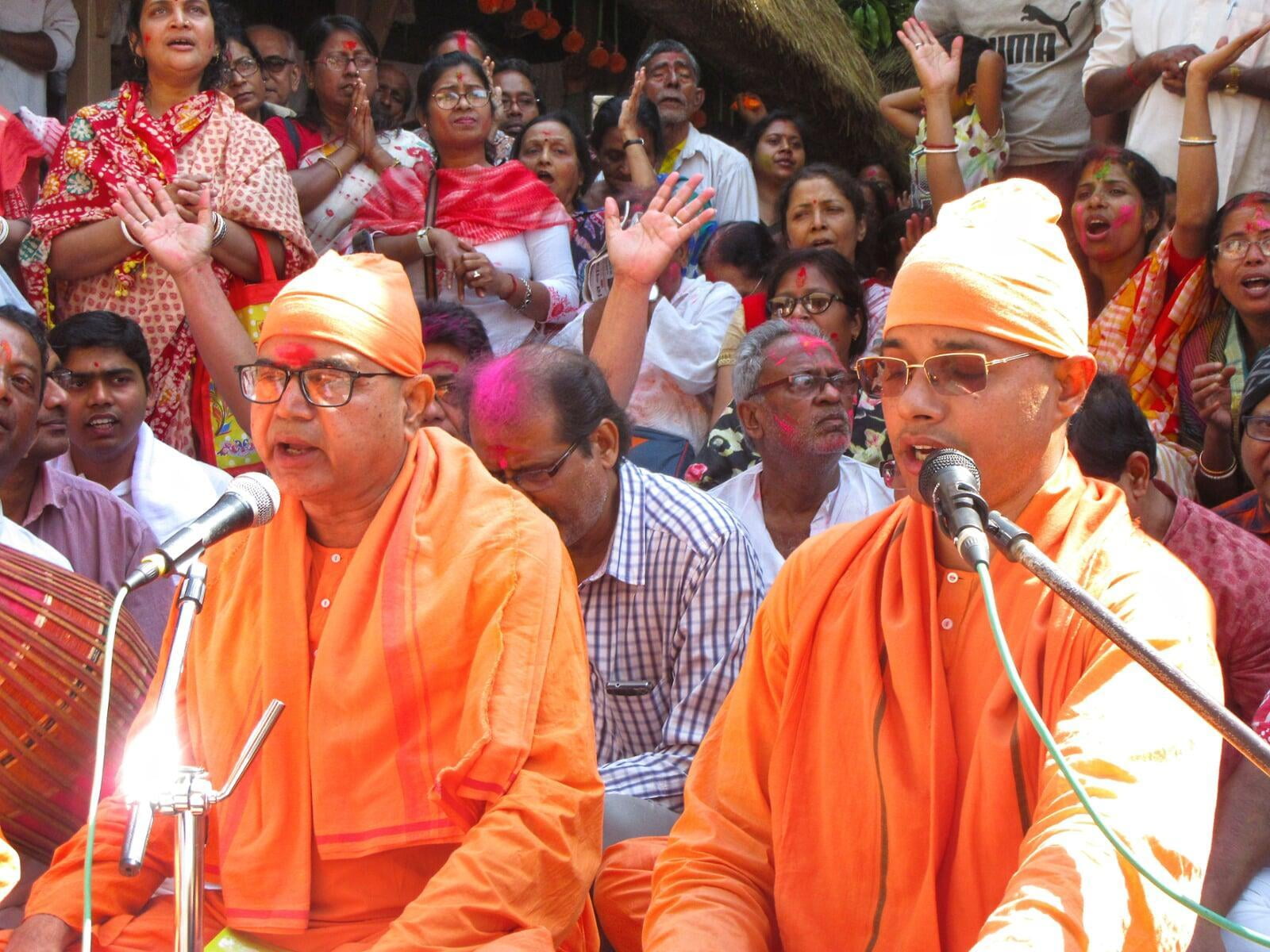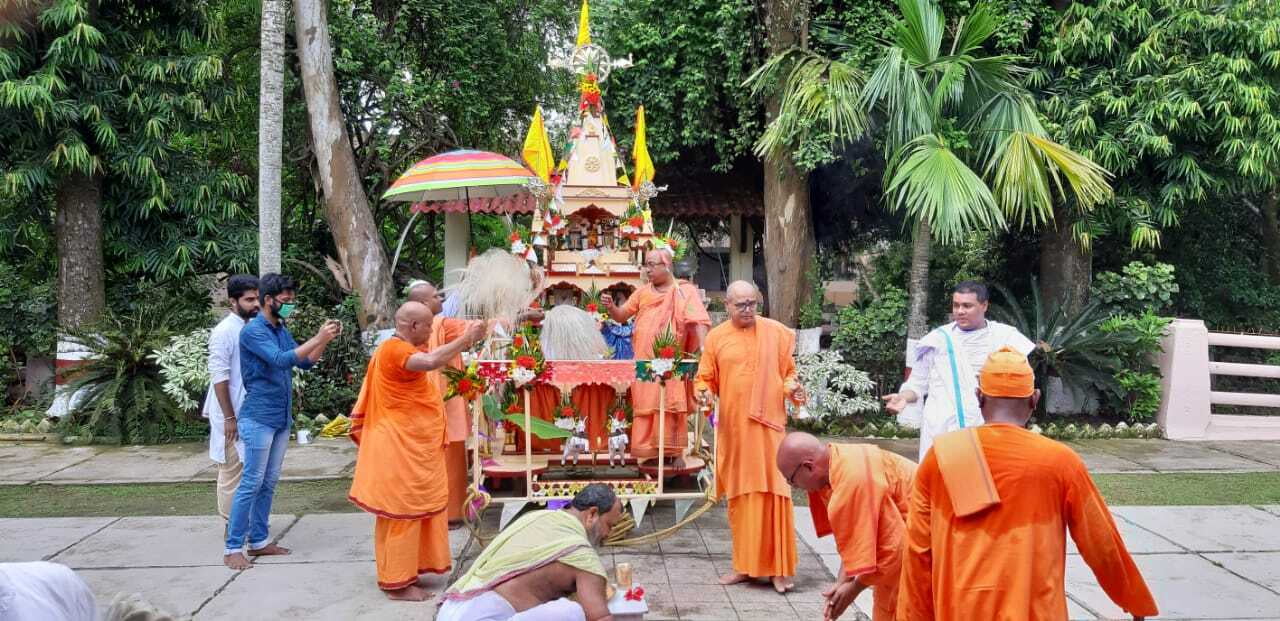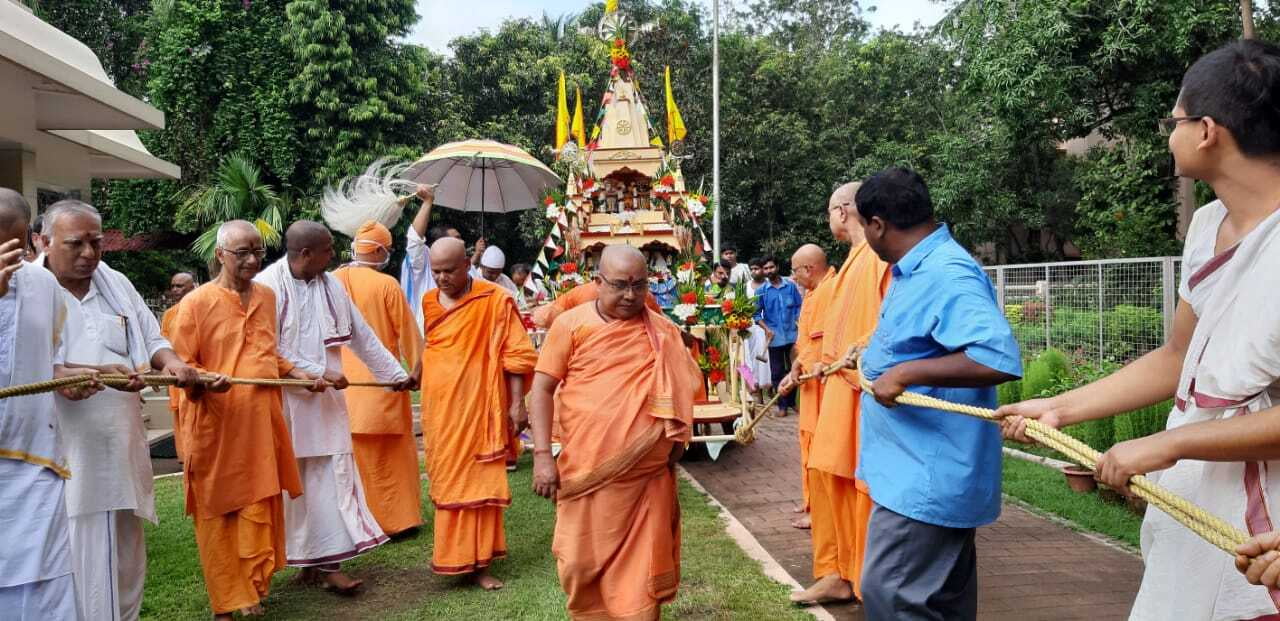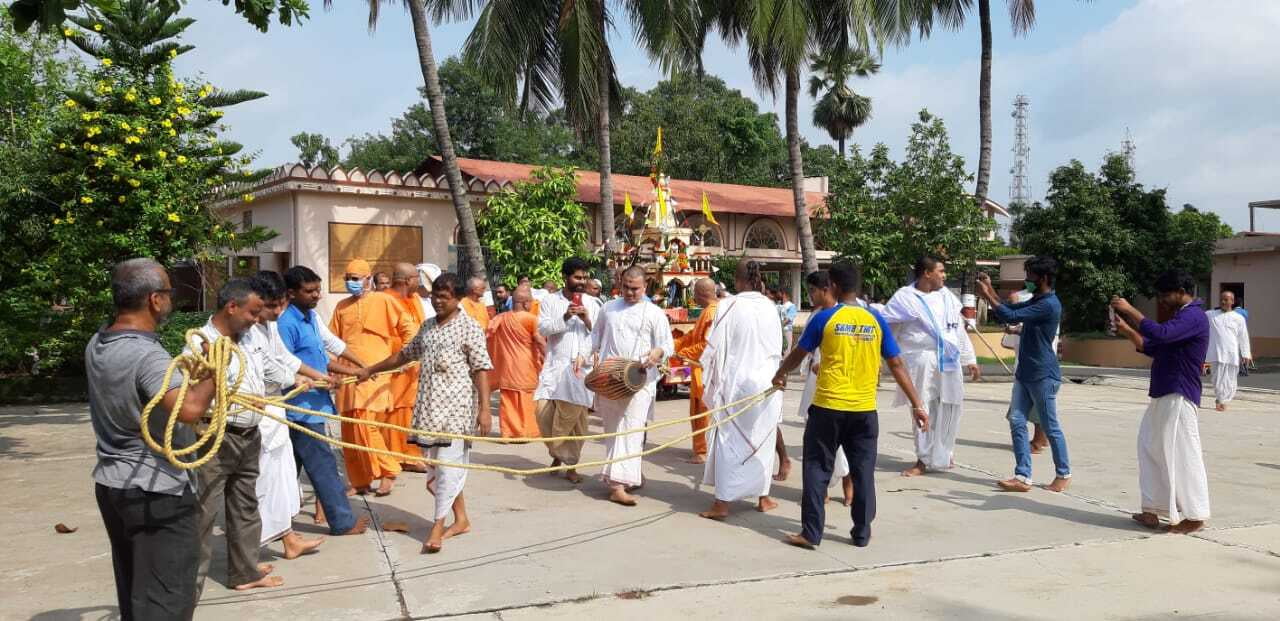Daily Worship and Prayers

Daily Worship and Prayer Time :
Carry out daily worship, araties and religious discourses at regular intervals as below : -
| PROGRAMME | APRIL - SEPTEMBER (IST) | OCTOBER - MARCH (IST) |
| Mangalarati | 04.00 AM | 04.30 AM |
| Morning Prayer | 05.45 AM | 05.45 AM |
| Daily Worship | 07.30 AM | 07.30 AM |
| Religious Talk | 09.00 AM | 09.00 AM |
| Evening Arati & Evening Prayer | After Sunset | After Sunset |
| Religious Discourse | After Sandhyarati | After Sandhyarati |
Besides daily worship, religious discourses inside and outside the Math, spiritual retreats and spiritual counselling by the senior monks, the Centre celebrates birthdays of the Holy Trio and other religious personalities. Sri Durga Puja, Sri Kali Puja, Sri Jagannath Mahaprabhu Rath Festival, Christmas Eve, Shivaratri and other occasions are also observed. On Ekadashi days Ramnam & on Purnima days (full moon) Shyamnam Sankirtan are held. The concluding function of the 150th Birth Anniversary of Swami Vivekananda was observed through various programmes throughout the year with due solemnity and enthusiasm.
Durga Puja Celebration
DURGA PUJA AT MATH
Durga Puja was first celebrated at Belur Math in 1901. Since then Durga Puja has been celebrated at Belur Math year after year, although for a few years after the first celebration in 1901, Pratima worship was not done. (In this connection it should be mentioned that Durga Puja was conducted on a small scale, without the image, by the disciples of Sri Ramakrishna during the early years of Ramakrishna Math at Baranagar.) It was Swami Vivekananda himself who started the first Durga Puja with the image at Belur Math. As a rule, Hindu Sannyasins do not conduct this kind of ritualistic worship. Why then did Swamiji start the new tradition?
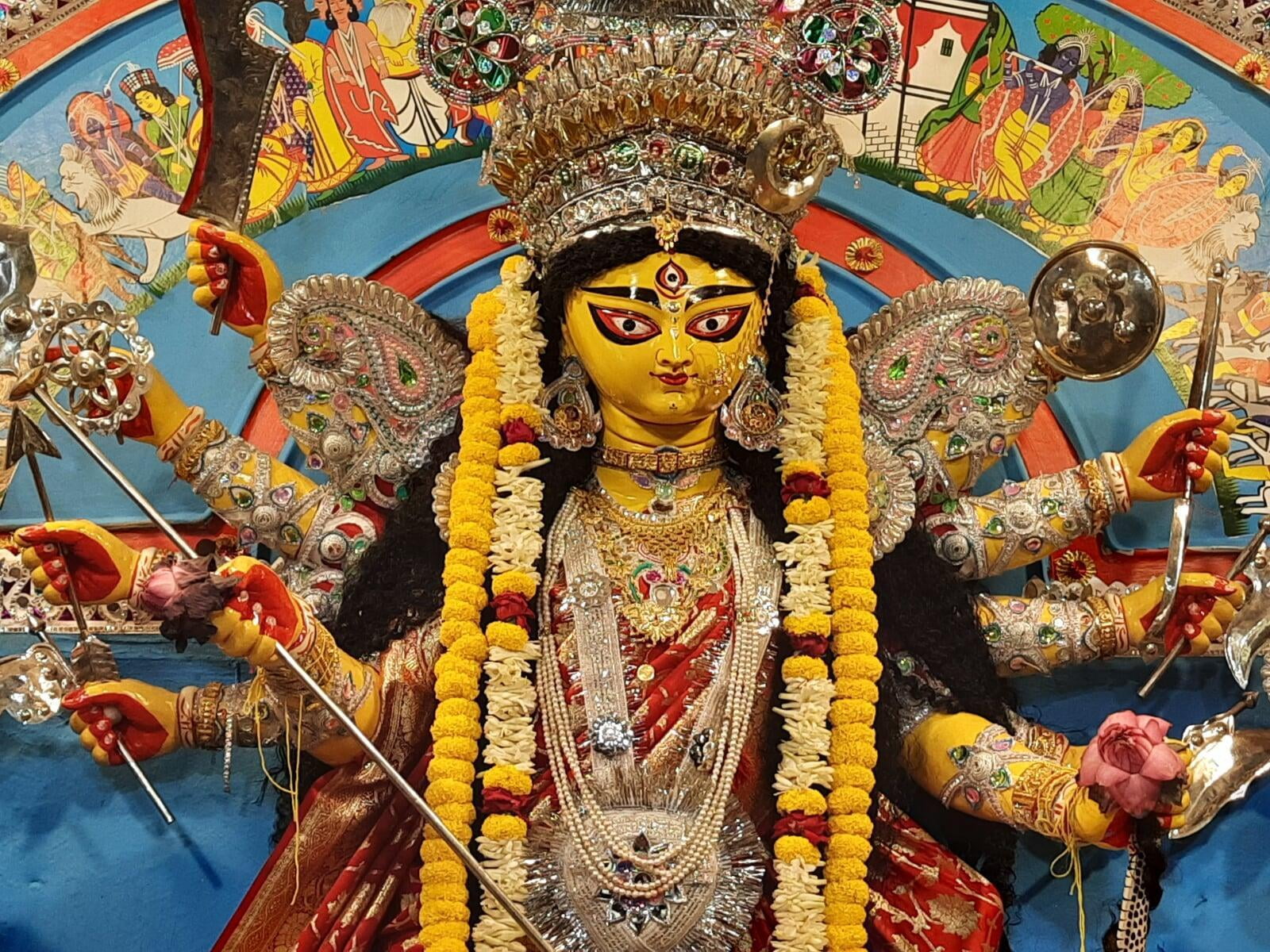
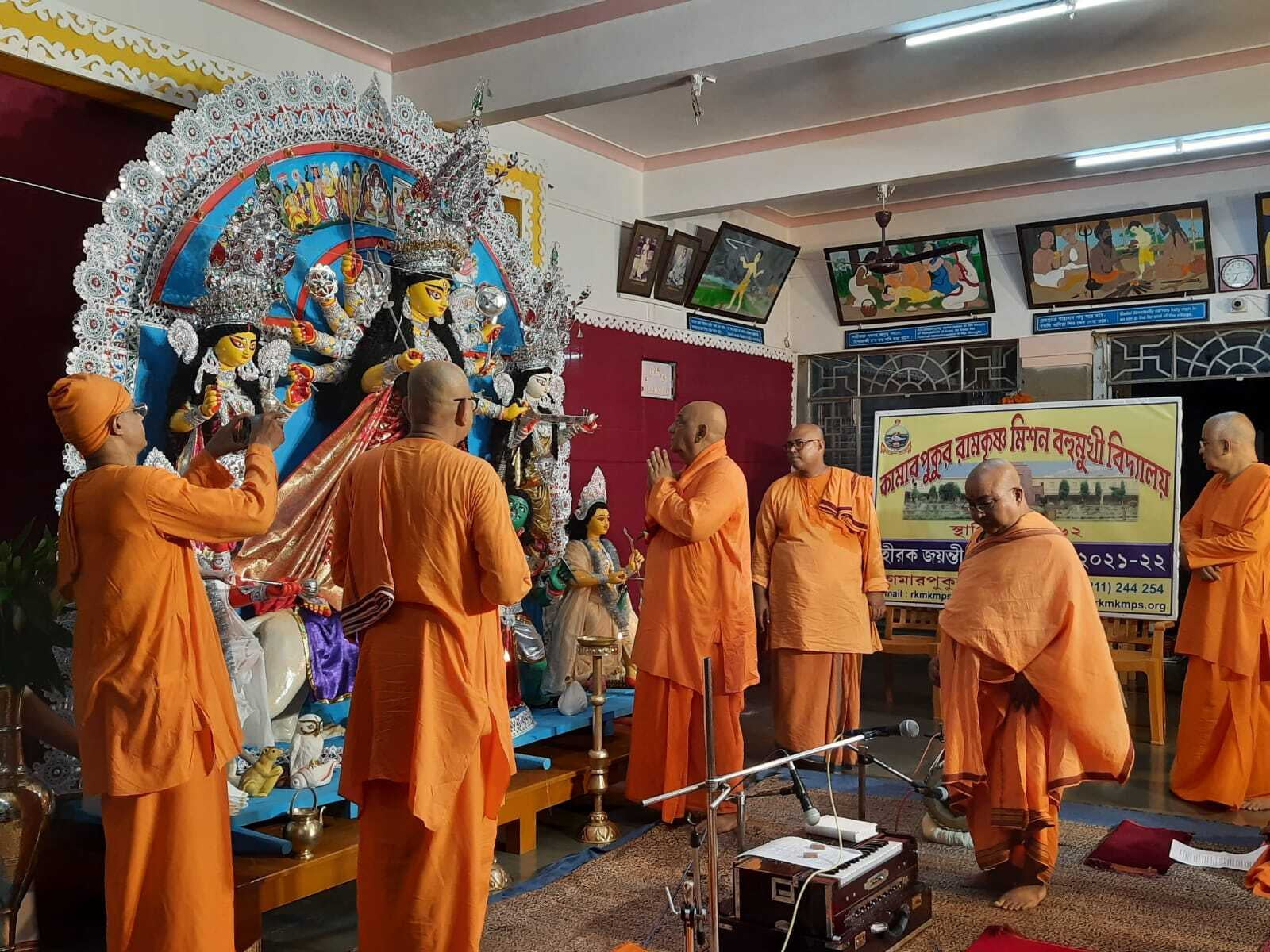
One reason was to gain the acceptance of the local community for the new way of life that Swamiji and his monastic brothers were leading. The Hindu society in Calcutta had not fully accepted Swamiji's going to the West, and the rather unconventional ways of life at Belur Math which included disregard for caste rules and mixing with Western people. As a matter of fact, the celebration of Durga Puja helped to remove much of the misunderstanding and misgivings about the new monastic institution among the local people.
Another reason was Swamiji wanted to institutionalize respect for divinity of motherhood and sanctity of womanhood. Swamiji saw that one of the main reasons for the advancement of Western people
You can edit text on ywas the elevation of women in the West, and one of the main reasons for the backwardness of India was the neglect of women in this country. Worship of the Divine Mother, especially the Kumari Puja, would create the awareness of the potential divinity of women and a respectful attitude towards them.our website by double clicking on a text box on your website. Alternatively, when you select a text box a settings menu will appear. your website by double clicking on a text box on your website. Alternatively, when you select a text box
Holy Mother and Durga Puja
When Swamiji decided to celebrate Durga Puja at Belur Math, one of the first things he did was to seek the approval of Holy Mother Sarada Devi who was then staying at Baghbazar in Kolkata. Swami Premananda went to Mother, and Mother whole-heartedly approved the proposal. On Shashthi day She came with other women devotees and stayed at Nilambar Babu's garden house nearby. Mother attended the awakening ceremony that day and attended the Puja on all the three subsequent days.
Holy Mother attended the Durga Puja at Belur Math in 1912 and in 1916 and perhaps in some other years also. Each time Mother stayed for a few days and blessed Her monastic and lay children.
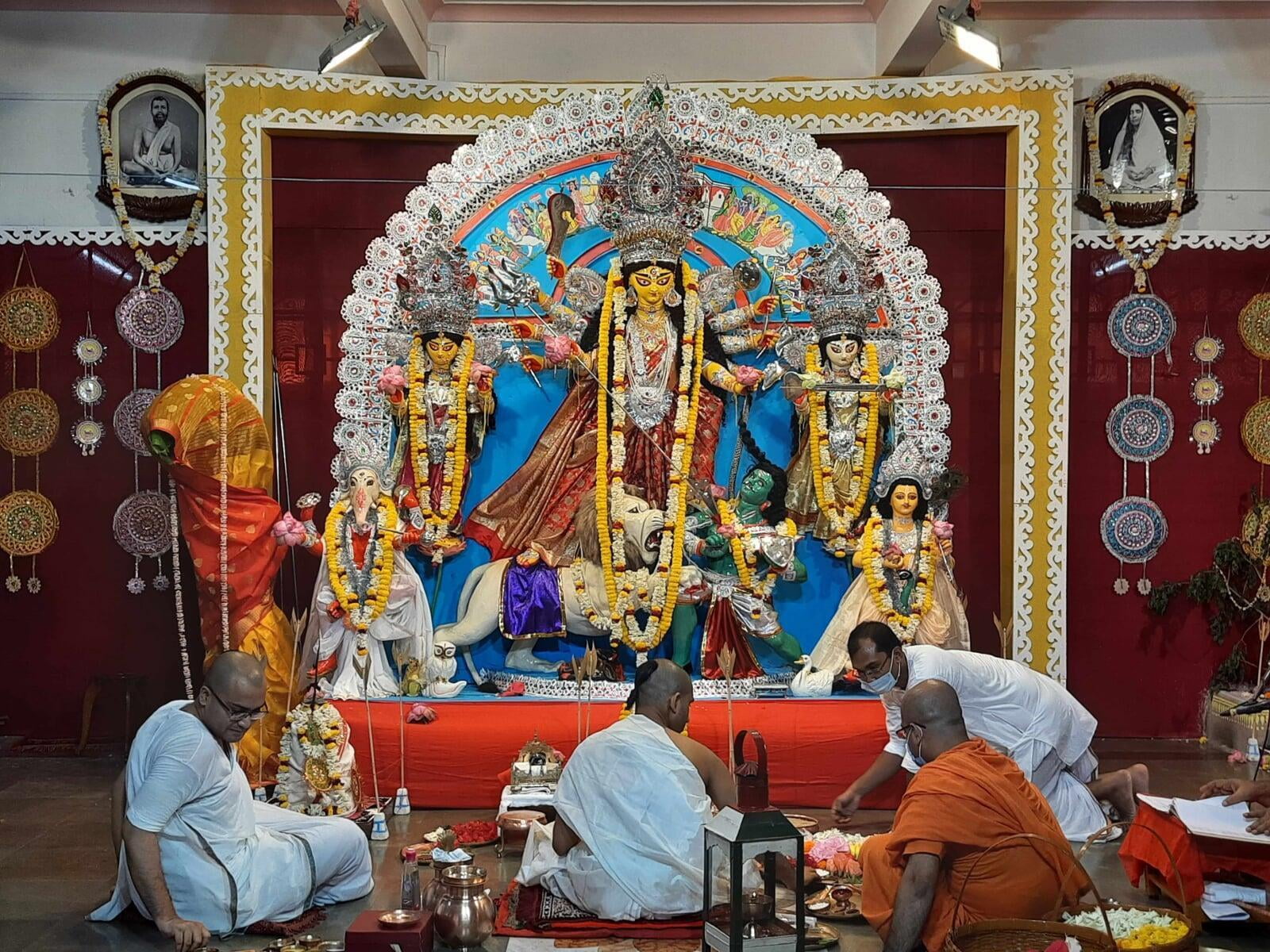
Agamani
As already mentioned elsewhere, several mythological legends underlie Durga Puja festival. One of these is the legend that every year during the Navaratri, Goddess Uma, who is identified with Parvati the divine consort of Shiva, comes to the home of her parents - Himavat and Menaka. In Bengal this legend has been universalized into the belief that the Divine Mother visits the homes of all her children during the three days of Durga Puja. Agamani songs are songs which vividly depict the maternal love and deep concern of Menaka for her divine daughter. They are sung to welcome Mother Uma into homes. They also reflect parents' love for their married daughters.
Swami Vivekananda was fond of Agamani songs because of the tender feelings expressed in them. On the Shashthi of the first Durga Puja at Belur Math, Swamiji sang Agamani songs such as, Giri Ganesh amar shubhakari etc. The tradition of singing Agamani songs continues in Belur Math. Every year from the first day (pratipada) after Mahalaya to the sixth day (Shashthi) Sadhus and Brahmacharins gather at the main temple of Sri Ramakrishna at dawn and sing Agamani songs in chorus. [At night, after Arati, they conduct Kalikirtan.
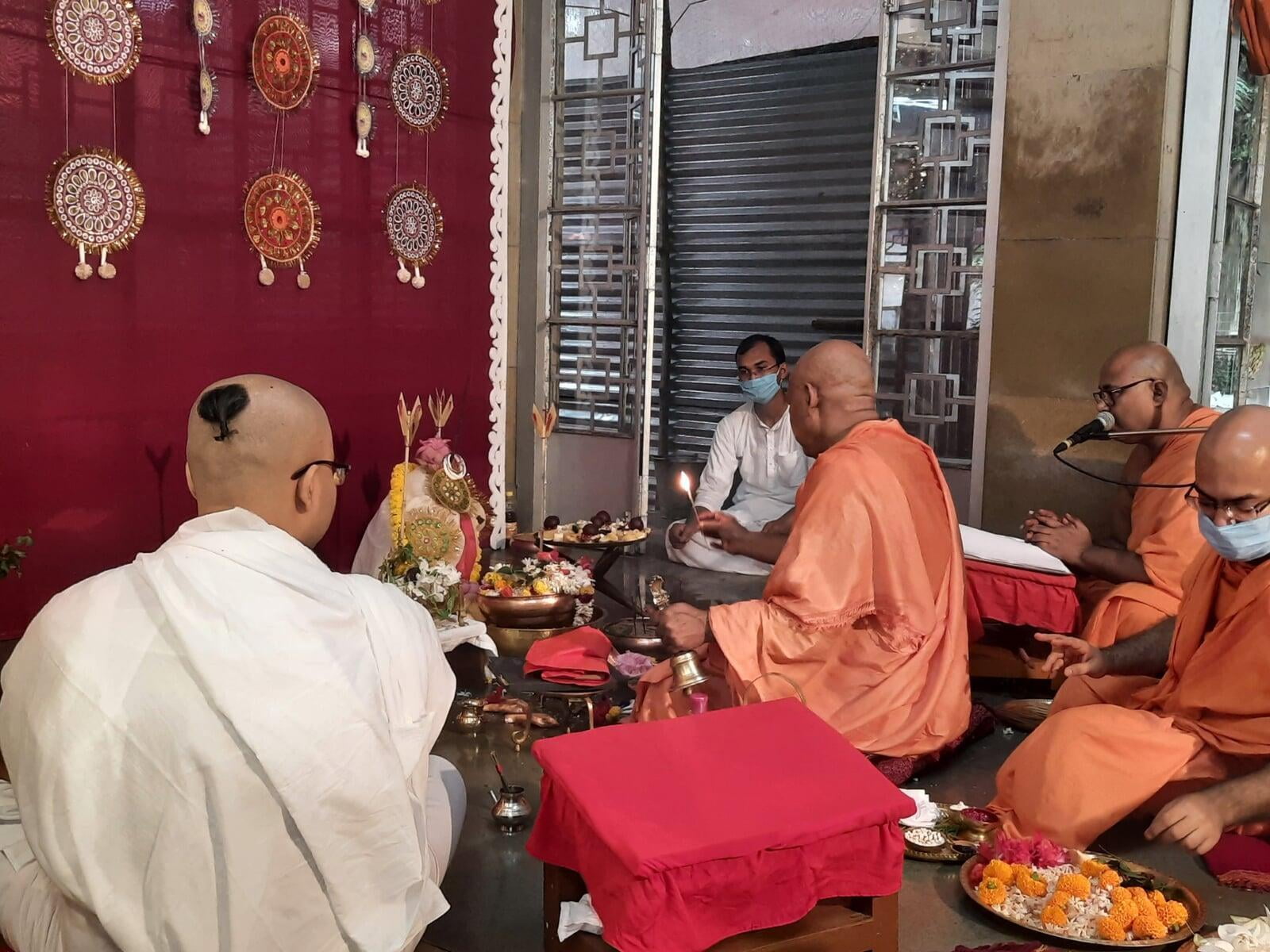
Chandipath
During the nine days of Navaratri the book Chandi is recited everyday morning. This recital is done along with worship of the Goddess Chandi. In Belur Math this is done during the first five days at a corner of Natamandir and from the 6th at a corner of Durga Mandap itself.
Shashthi : the 6th day
This is a very important day when ritual preparations are made to begin the Durga Puja proper. These preparations are mainly three: Kalparambha, Bodhan, Adhivas and Amantran.
Kalparambha : This ritual is done early in the morning. It is mainly an act of making the samkalpa or ''sacramental intention'', the firm determination to conduct the Puja properly during the three days. The ritual consists of installing the ghata, water-filled copper pot, at a corner of Durga mandap and offering worship to Durga and Chandi.
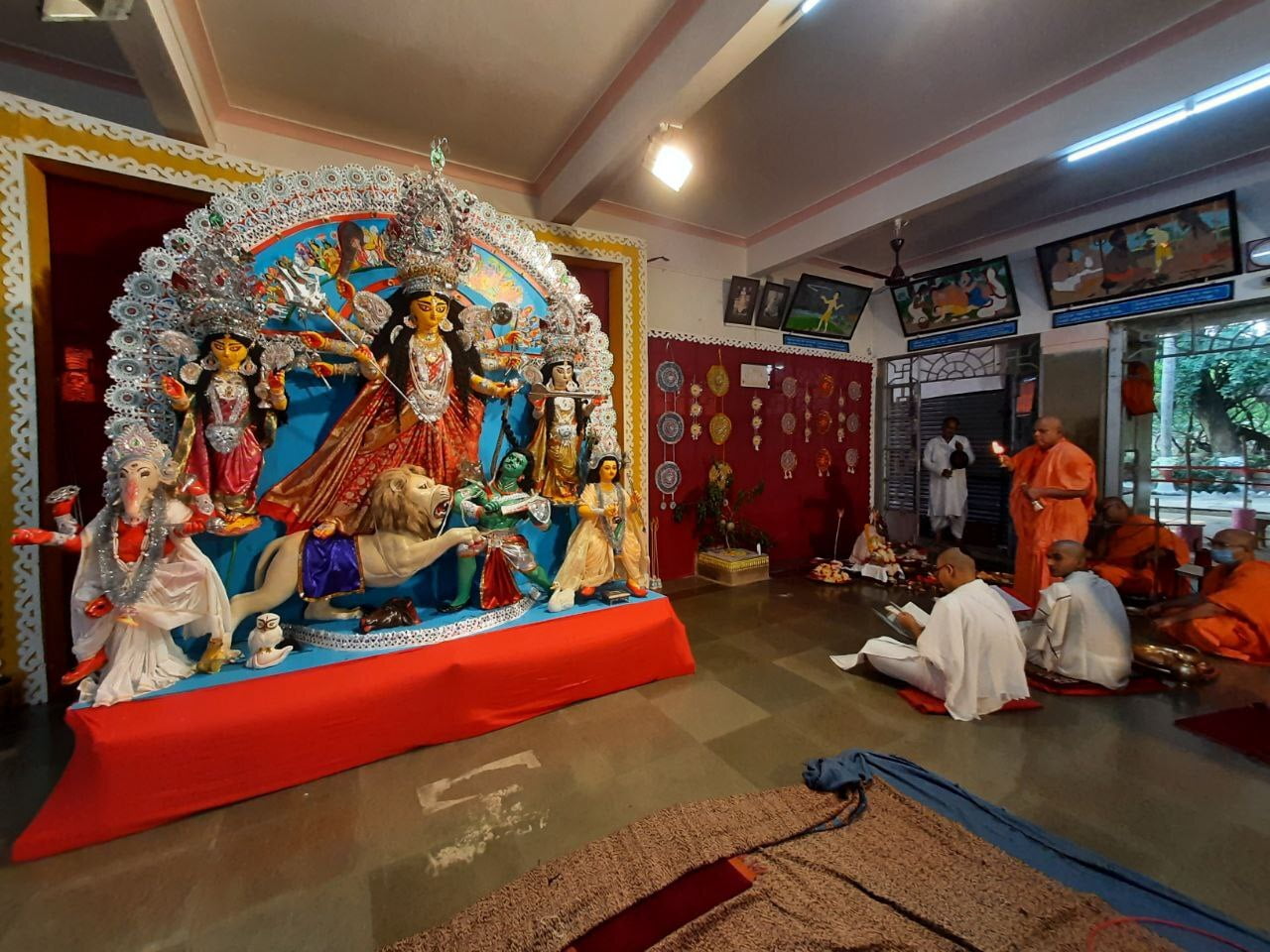
Bodhan: This rite is performed at the Sandhya or dusk. The word ‘Bodhan' literally means ‘awakening'. As already mentioned elsewhere, the Hindu mythology holds that all gods and goddesses go to sleep for six months during the southward journey of the Sun. Autumn (Sharat), during which Durga Puja is done, falls in the middle of this period. Hence it is necessary to first of all awaken the deity Durga. We have already mentioned that the awakening of Durga was first done by Sri Ramachandra who wanted to propitiate the Goddess before fighting Ravana. The ritual of Bodhan consists in installing a water-filled copper vessel at the base of the Bel (Bilva) tree (or, as is now done at Belur Math, keeping a branch of the Bel tree in the pot) and praying to the Divine Mother to awaken.
Adhivas and Amantran : These rites follow Bodha. Adhivas means ''invocation''. Through Bodhan the Devi has awakened: now the awakened Devi has to be invoked in the Bel tree or branch of the tree. Adhivas is also a ritual of sanctification. The actual ritual consists of the following main steps. Devi Durga and the Bel tree are first worshipped Twenty-six sacramental things (mangalik dravya) are sanctified by touching Devi Durga and the Bel tree with them. To ward off evil effects, a red coloured thread is tied around the altar where Puja is done.
The above ritual is followed by Amantran which literally means ''invitation''. Through this rite the Devi is invited or entreated to accept the Puja the next day (Saptami). After this, Devi is worshipped with five items and Arati is done to Her.
Saptami Puja
The important point to note here is that a living medium is necessary to invoke the indwelling of a deity. It is through a living medium that Divinity manifests itself. On the sixth day Divinity was invoked in the Bel tree or a branch of it. On the seventh day the Deity is invoked in a group of nine plants known as Navapatrika. The nine plants, which include a branch of Bel tree also, are bundled together, given a ceremonial bath, covered with an orange coloured cloth and installed on a wooden seat on the right side of the image of Durga. This is followed by Mahasnan (great bath) on a mirror, using various materials. After this, consecration and divinization of the image, known as pranapratishtha, takes place.

This is followed by elaborate worship of the Devi with sixteen items (shodashopacharapuja). The other deities, attendants and other objects associated with Devi are then worshipped. The Seventh Day's Puja is concluded with bhog (food offering) and Arati to Devi.
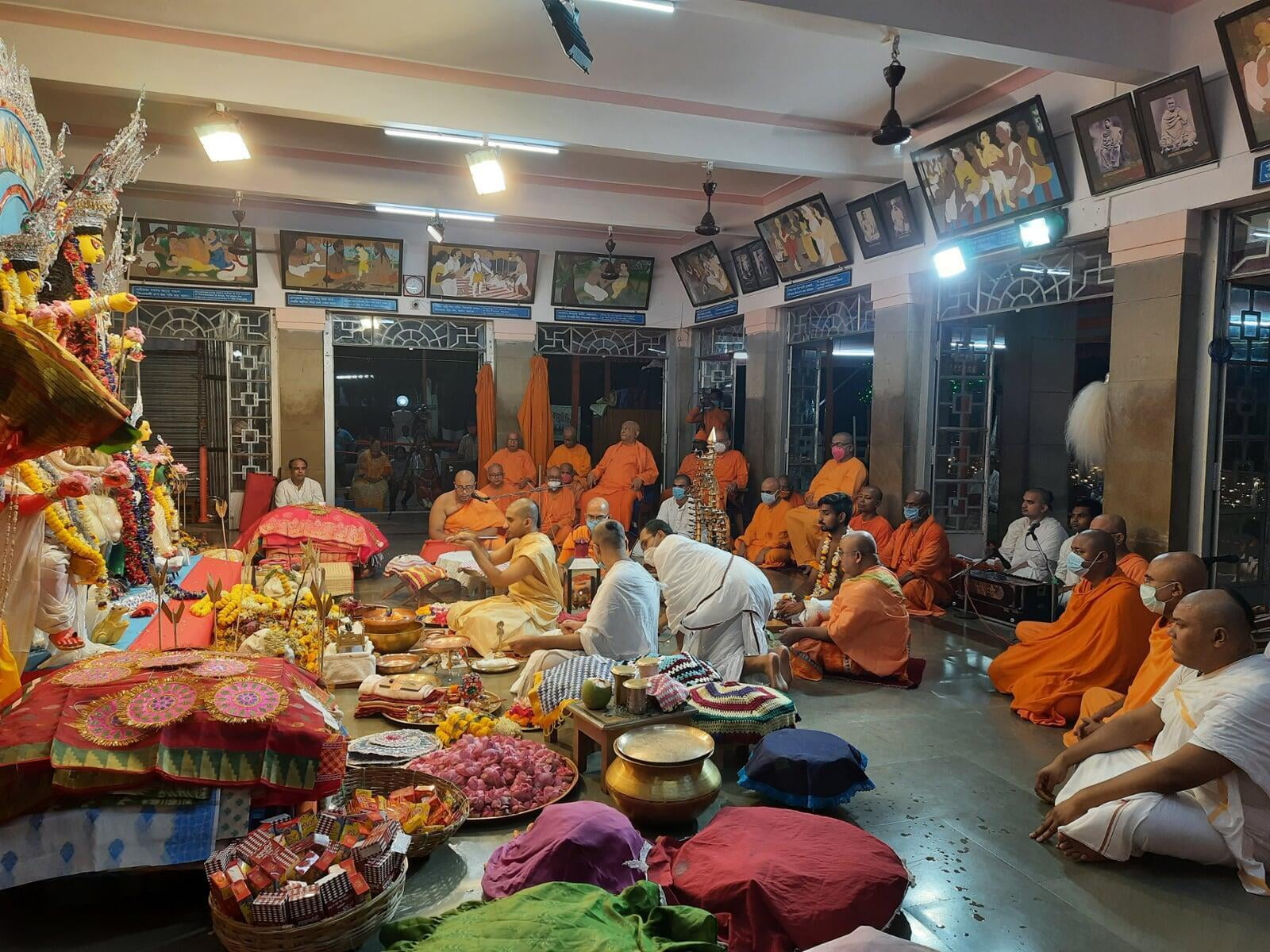
Ashtami Puja
As on Saptami, on Ashtami also, Mahasnan and Shodashopacharapuja are done. In addition, nine small pots with flags of different colours attached are installed and the Nine Shaktis are invoked in them and worshipped. After this sixty-four yoginis are worshipped. Then one crore yoginis are worshipped. This is followed by worship of Nava Durga (nine aspects of Durga) and Goddesses Jayanti, Mangala, Kali, Bhadrakali, Kapalani, Durga, Shiva, Kshama, Dhatri, Svaha and Svadha. Ashtami Puja is concluded with Bhog and Arati.
Kumari Puja :
Worship of a young girl, treating her as Devi, is also a part of Ashtami Puja. Sri Ramakrishna has said that the Divine Mother manifests herself more in a pure-hearted girl and that is why Kumari Puja is done. He used to bow down before little girls looking upon them as manifestations of the Divine Mother. When Durga Puja was done at Belur Math for the first time, Swami Vivekananda worshipped several Kumaris. Now only one Kumari is worshipped. The same kinds of offerings made to the Devi are given to the Kumari also, and finally Arati is performed. Even senior monks offer flowers at her feet.
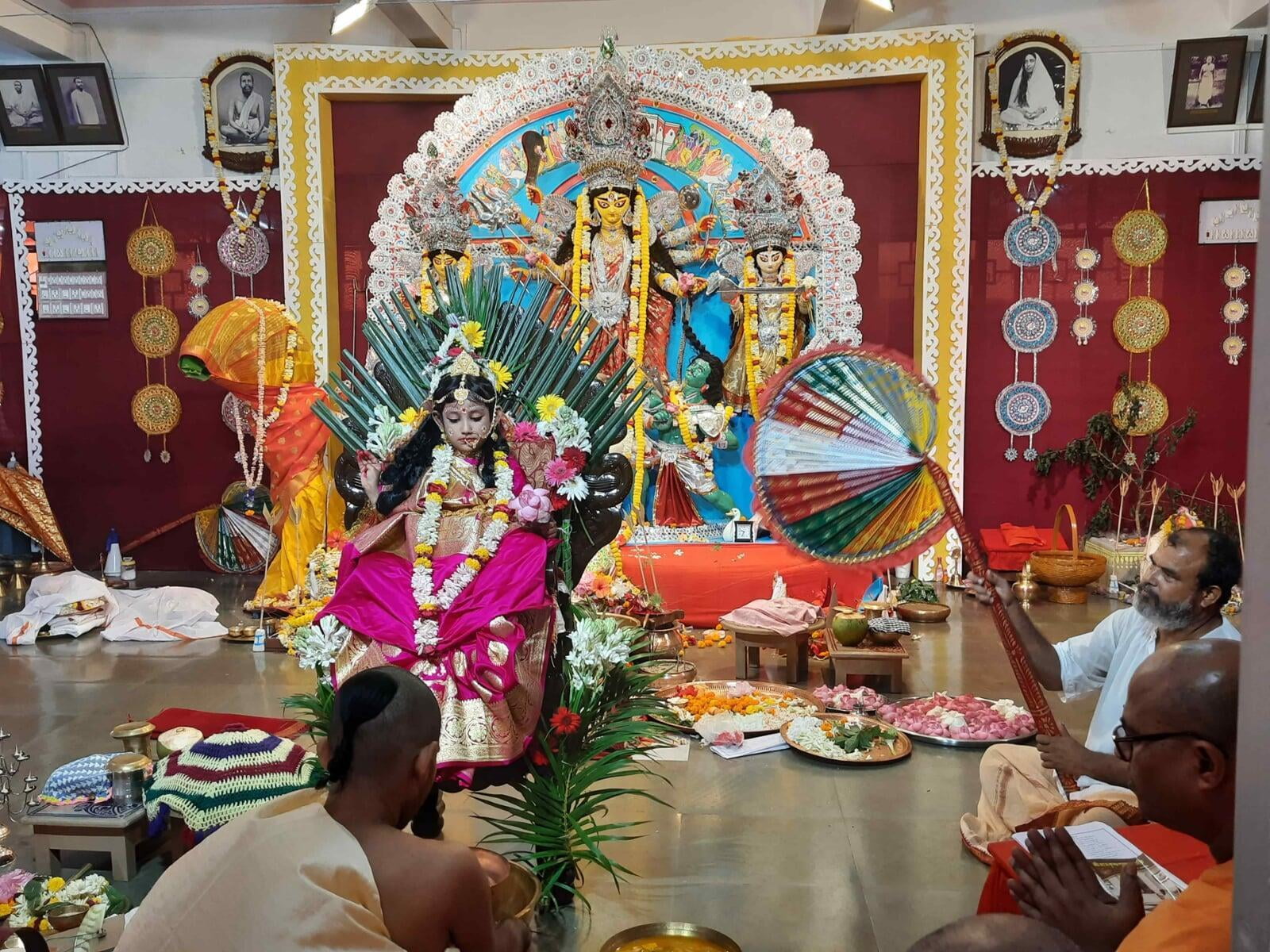

Sandhi Puja :
The last 24 minutes of Ashtami and the first 24 minutes of Navami (a total of 48 minutes between the two lunar days) constitute the Sandhi or ''Sacred Juncture''. It is considered to be a most auspicious time. At this time Durga is worshipped as Chamunda (that is, Kali who killed the demon Chanda and Munda). This Puja is considered to be the highest point in the whole Durga Puja and the most important ritual. It is customary to perform bali or animal sacrifice at this sacred juncture. When the first Durga Puja was celebrated at Belur Math in 1901, Swami Vivekananda wanted to have bali done. But Holy Mother prohibited it and, in obedience to Holy Mother's injunction, animal sacrifice is never done at Belur Math. Instead, a banana is ‘sacrificed' as a symbolic bali.
Navami Puja
As in Ashtami, during Navami also Mahasnan and Shodashopacharapuja are offered to Devi. In addition, bali and Homa are performed. In Belur Math for bali white pumpkin and sugarcane are offered. The Homa (fire sacrifice) is a combination of Vedic and Tantric traditions.
Dashami Puja
In the morning a brief Puja, Shital bhog (cooling food offering) and Arati are first done. Then the Pujari and Tantradharak circumambulate the altar and perform the visarjan ritual. In this ritual the Devi, who had been invoked in the Navapatrika and consecrated Image, is entreated to return to Her celestial abode. The Divine Mother, however, dwells for ever in the hearts of devotees.
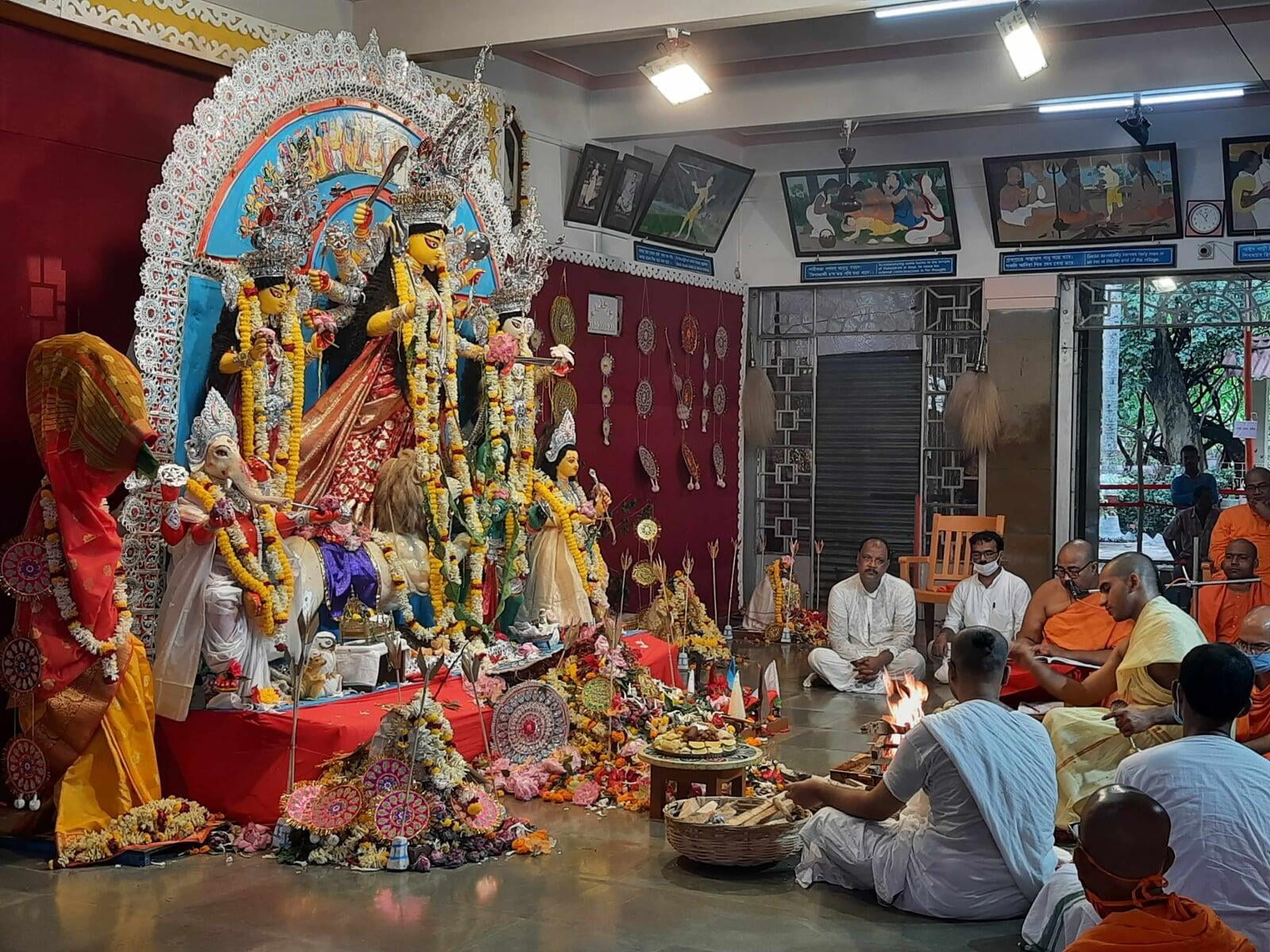
In the evening the Image of Durga along with Navapatrika is taken in procession to the river bank and immersed in the river. The water taken from the spot, known as Shanti Jal is sprinkled on the devotees who embrace one another as an expression of their solidarity as children of the same Divine Mother. And thus the holy Durga Puja comes to an end leaving joyous memories in the souls of people.
